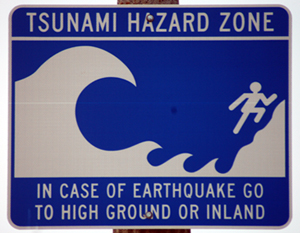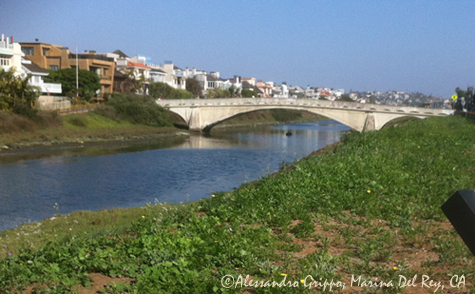 |
GEOL 31 - Physical Oceanography
Exam # 3 Study Guide - Spring 2014
exam date and time: Thursday, June 16, 2014 at 8:00 AM
Professor: Dr. Alessandro Grippo, Ph.D.
|
|
| |
| General Information | Last Updated • May 31, 2014 | |
PLEASE NOTE:
- As per college rules, the final exam will start at 8:00 instead of the usual meeting time of 9:30. Please note that if you arrive to class later than 8:00, AND some other student has already turned in the test, you would not be allowed to take it. So, be there at 8:00!
- Only students who are enrolled in the class can take the test. If you are not enrolled YOU CAN NOT TAKE THE TEST.
- You CAN NOT USE cellular phones, iPods, iPads, Kindles of any kind, Blackberries, Bluetooth, headphones, computers, pocket calculators, translators or, in general, ANY KIND of electronic device during the test.
All electronic devices MUST BE TURNED OFF: if a cell phone rings, or if a device is left on during test time, you will not be allowed to finish your test, your results will be invalidated and you will be reported to the college for disciplinary action.
- You can not use any text, notes, dictionary, pocket calculator, flash card, or any other source of information than your brain. If you do, you will not be allowed to finish your test, your results will be invalidated and you will be reported to the college for disciplinary action.
- You will NOT need a ruler or a blue book for this test.
- You will ONLY need to bring:
- one Scantron, Form 882-E
- a number 2 pencil
- an eraser
- This study guide must be interpreted (literally) as a guide to the study of the subject and not as a listing of possible questions.
- On this study guide, there is no additional or extra information compared to what has been said, discussed, shown, illustrated in class.
- It is YOUR personal responsibility to cover the materials listed below on the lecture textbook, on the lab textbook, on "Cradle of Life", on the web pages, and on your notes.
- I would strongly recommend that you integrate your notes with the textbook materials for completeness of information: some information that has been detailed in class is only mentioned briefly on the textbook, and you are responsible for covering that.
- Know what the key terms and the concepts are (see the list at the end of each chapter on your textbook); exercise with the questions for review also found at the end of each chapter. Read the summary ("Chapter in Review") at the end of each chapter. Try to work with other fellow students if you find it useful.
- Never hesitate to ask questions in class.
 A tsunami warning sign
in Santa Monica, California.
© 2012 Alessandro Grippo, All Rights Reserved.
| |
| Study Guide | Last Updated • May 31, 2014 | |
Chapter 7 - Ocean Circulation
Study the whole chapter
- Know the Introduction
- Know How Are Ocean Currents Measured?
- Know How Are Ocean Surface Currents Organized?
Be sure to study all the subparagraphs. Review figure 7.5, page 203, table 7.1, page 203, figures 7.6 and 7.7, page 205, figure 7.8, page 207, table 7.2, page 208, and figure 7.9, page 209.
- Know What Causes Upwelling and Downwelling?
Be sure to study all the subparagraphs. Review figures 7.10 and 7.11, page 210, and figures 7.12 and 7.13, page 211.
- Know What Are the Main Surface Circulation Patterns in Each Ocean?
Be sure to study all the subparagraphs and to review all figures, including figure 7.21, page 219 and figure 7.22, page 220.
- Know What Deep Ocean Currents Exist?
Be sure to study all the subparagraphs. Review figure 7.27, page 226, figure 7.28, page 227, and figure 7.29, page 228
- Know Can Power from Currents Be Harnessed as a Source of Energy?
Chapter 8 - Waves and Water Dynamics
Study the whole chapter
- Know the Introduction
- Know What Causes Waves?
- Know How Do Waves Move?
- Know What Characteristics Do Waves Possess?
Be sure to study all the subparagraphs.
Be sure to review and understand Figures 8.2 and 8.3, page 237, and Figure 8.4, page 238.
- Know How Do Wind-generated Waves Develop?
Be sure to study all the subparagraphs.
Be sure to review and understand Figures 8.9 and Figure 8.10, page 242, Figure 8.14, page 245, Figure 8.15, page 246, and Figure 8.16, page 247.
- Know How Do Waves Change in the Surf Zone?
Be sure to review and understand Figures 8.19, page 249, Figure 8.21, page 251, Figure 8.22, page 252.
- Know How Are Tsunamis Created?
Pay attention to Figure 8.24, page 254 and Figure 8.26, page 256.
- Know Can Power From Waves Be Harnessed as a Source of Energy?
Chapter 9 - Tides
Study the whole chapter
- Know the Introduction
- Know What Causes Oceane Tides?
Be sure to study all the subparagraphs.
Pay attention, in particular, to Figure 9.7, page 271, and Figures 9.8 and 9.9, page 272.
- Know How Do Tides Vary During a Monthly Tidal Cycle?
Be sure to study all the subparagraphs.
Study Figure 9.10, page 273, Figure 9.11, page 274, Figures 9.12 and 9.13, page 275, and, very important, Figure 9.14, page 276.
- Know What Do Tides Look Like in the Ocean?
Read the subparagraph "Amphidromic Points and Cotidal Lines", but study the rest of this paragraph.
- Know What Types of Tidal Patterns Exist?
Know all of these patterns well, and review them in Figure 9.16, page 279, and Figure 9.17, page 280.
- Know What Tidal Phenomena Occur in Coastal Regions?
- Know Can Tidal Power Be Harnessed as a Source of Energy?
Chapter 10 - The Coast: Beaches and Shoreline Processes
Study the whole chapter
- Know the Introduction
- Know How Are Coastal Regions Defined?
Be sure to understand the terminology in Figure 10.1, page 292.
- Know How Does Sand Move on the Beach?
Be sure to review Figure 10.2, page 293, and Figure 10.3, page 294.
- Know What Features Exist Along Erosional and Depositional Shores?
Be sure to study all the subparagraphs.
Review Figure 10.4, page 295, Figure 10.7, page 298, Figure 10.10, page 300, Figure 10.11, page 301, and Figure 10.12, page 302.
- Know How Do Changes in Sea Level Produce Emerging and Submerging Shorelines?
Be sure to know this section well.
Review Figure 10.14, page 304, Figure 10.15, page 305, and Figure 10.16, page 306
- Know What Characteristics Do U.S. Coasts Exhibit?
- Know What is Hard Stabilization?
Be sure to study all the subparagraphs.
Review in particular Figure 10.20,page 311, and Figure 10.22, page 312.
- Know What Alternatives to Hard Stabilization Exist?
Chapter 11 - The Coastal Ocean
Study the whole chapter
- Know the Introduction
- Know What Laws Govern Ocean Ownership?
- Know What Characteristics Do Coastal Waters Exhibit?
Review Figure 11.3, page 323, Figures 11.4 and 11.5, page 324.
- Know What Types of Coastal Waters Exist?
Be sure to study all the subparagraphs.
Review Figures 11.7, page 327, Figure 11.8, page 328, Figure 11.9, page 329, Figures 11.10 and 11.11, page 330, and Figure 11.12, page 331.
- Know What Issues Face Coastal Wetlands?
- Know What is Pollution?
- Know What Are the Main Types of Marine Pollution?
Be sure to study all the subparagraphs.
Chapter 12 - Marine Life and the Marine Environment
Study the whole chapter
- Know the Introduction
- Know What Are Living Things, and How Are They Classified?
Be sure to study all the subparagraphs.
Know Figure 12.1, page 360.
- Know How Are Marine Organisms Classified?
Know this section well.
Review Figure 12.4, page 364, Figures 12.5 and 12.6, page 365, and Figure 12.7, page 366.
- Know How Many Marine Species Exist?
- Know How Are Marine Organisms Adapted for the Physical Conditions of the Oceans?
Be sure to study all the subparagraphs.
Review Figures 12.11 and 12.12, page 370, Figure 12.15, page 372, and Figure 12.18, page 375.
- Know What Are the Main Divisions of the Marine Environment?
Be sure to know this section well.
Know Figure 12.25, page 380, Figure 12.26, page 381.
Also, be sure to review Figure 13.1, page 388, from Chapter 13.
Chapter 13 - Biological Productivity and Energy Transfer
Study the whole chapter
- Know the Introduction
- Know What Is Primary Productivity?
Be sure to study all the subparagraphs. Review Figure 13.1, page 388, Figure 13.3, page 391, Figure 13.6, page 394.
- Know What Kinds of Photosynthetic Marine Organisms Exist?
Be sure to study all the subparagraphs, which refer to the four different categories of photosynthetic organisms we have seen. You should know in particular the names and characteristics (including why they are so important) of Microscopic Algae.
- Know How Does Regional Primary Productivity Vary?
Know this paragraph very well. Review in particular Figure 13.18, page 404, Figure 13.19, page 405, Figure 13.20, page 406, and Figure 13.21, page 407.
- Know How Are Energy and Nutrients Passed Along in Marine Ecosystems?
Be sure to study all the subparagraphs and to review Figure 13.22, page 408, Figure 13.23, page 409, Figures 13.26 and 13.27, page 411, Figures 13.28 and 13.29, page 412.
- Know What Issues Affect Marine Fisheries?
Be sure to study all the subparagraphs. Review ALL figures, and in particular Figure 13.30, page 413, and Figure 13.35, page 417.
 An example of a partially urbanized coastal wetland
in Marina del Rey, California.
© 2012 Alessandro Grippo, All Rights Reserved.
Go back to the home page  Go back to the Spring 2014 page
Go back to the Spring 2014 page
|
|
|
| |
Copyright © 1994-2014, Alessandro Grippo, All Rights Reserved.
|



 Go back to the Spring 2014 page
Go back to the Spring 2014 page